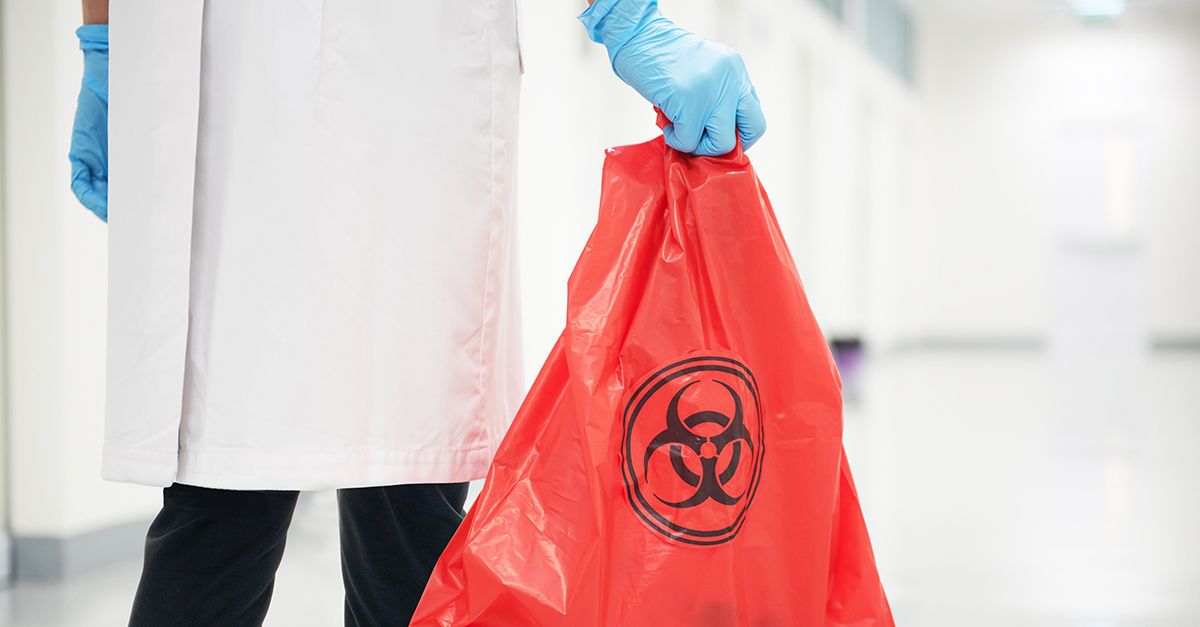Bodily fluids are the most significant biohazard risk to cleaning professionals who maintain restrooms. Exposure to biological fluids and agents such as saliva, urine, mucus, vomit, feces, blood, and other potentially infectious materials (OPIM) is a constant danger when cleaning restrooms.
“Handling human blood and related products can increase the risk of exposure to infectious agents like HIV, hepatitis B, and hepatitis C,” Marilyn Clifton, La Rabida Children’s Hospital environmental services manager, explained.
Biohazard threats are topmost around toilets and urinals due to accidents such as poor aim when urinating or vomiting.
“Blood and OPIM should always be considered infectious using standard precautions,” said Mark Heatley, Aramark Healthcare+ quality and standards manager. “Toilet handles, walls, and
the floor around the toilet also pose a threat when splash has occurred and is another reason why it is critical to wash your hands thoroughly after [restroom] use.”
Infection protections
To protect themselves from biohazards, teams should heed risk mitigation procedures and use personal protective equipment (PPE).
“We have our standard PPE, adding additional PPE such as double glove, disposable gown, mask, and eye protection based on the circumstances or type of isolation in place,” said Isaac Johnson,
MESRE, Aramark Healthcare+ senior vice president of operations. “Proper training of the team helps to mitigate the risks. Proper training through role-playing is a great activity to get your teams comfortable with practicing proper cleaning procedures. This allows the team to make mistakes in a controlled environment.”
Nora Gonzalez, Diverse Facility Solutions CPS account manager, agreed that employees are trained to clean, depending on the biohazard, place, and moment. Management ensures employees have biohazard kits on their carts and additional kits in nearby closets. Kits include gloves, aprons, glasses, shoe covers, a face shield, red biohazard trash bags, and hardening powder for fluids such as vomit. A designated mop is used for biohazards. “These tools help employees avoid any contact of any kind when cleaning,” she said.
Aramark Healthcare+ team training involves cleaning from the cleanest to the dirtiest area in any space. In the standard cleaning procedure for restrooms, the dirtiest area is always the toilet/urinal unless feces, urine, and/or blood are present in other areas within the restroom.
“We utilize reusable or disposable (based on location) microfiber cloths, mops, and toilet mops saturated with our approved disinfectants to clean the areas,” Johnson said. “It is vital that we utilize
the proper equipment and cleaning chemicals to maximize safety and efficiency when cleaning.”
Clifton offered the following process her teams use for cleaning biohazardous areas in restrooms:
- Organization: Identify affected areas and determine the scope of the cleanup.
- Removal: Remove visible biohazardous matter.
- Disinfection: Once the area is clean, disinfect it with U.S. Environmental Protection Agency (EPA)-approved products to kill pathogens.
- Waste disposal: Safely dispose of any hazardous waste.
Correct equipment
Standard biohazard cleaning equipment includes PPE, cleaning chemicals, and disposal supplies. Appropriate PPE includes masks, gloves, gowns, and shoe protection to be worn when cleaning
biohazardous restroom areas and dealing with biohazardous waste. Biohazard bags, sealed containers, and disposal boxes are necessary to collect and transport the waste securely. Professionals use EPA-approved disinfectants to disinfect the area and prevent the spread of infectious agents. Biohazard kits are also a must.
Aramark Healthcare+ teams use cleaning products such as microfiber cloths, mops, and toilet mops saturated with approved disinfectants. If bulk bodily fluid is present, it is removed with disposable products such as paper towels, microfiber cloths, or other absorbent products.
Diverse Facility Solutions relies on enzymatic cleaners, absorbent powders, and disinfectants.
Disposal of biohazardous waste involves placing the threat in a red biohazard bag and properly tying it shut with a ponytail knot. (The bag should be sealed so no liquid can escape if it is turned over.) If bulk liquid is involved, the addition of a solidifier should be standard practice, Johnson explained.
Procedures for emptying and cleaning feminine product receptacles differ by facility. Gonzalez said some airports might have service providers who empty the receptacles, with the frequency depending on airport traffic. But, if feminine products end up outside the containers, team members are trained to use proper PPE, including face shields, to remove the biohazard, she said.
Safety first
To ensure your cleaning team’s safety, the best practice is always to consider any blood or OPIM and follow proper precautions.
“If a teammate is not sure how to manage a situation, they should reach out to their leadership,” Heatley said. “It is essential to segregate biohazardous waste from regular waste; this includes liquids, solid waste, sharps, etc., and [everything] should be handled with extreme caution.”
Teams also can block off the affected area using caution and wet floor signs or safety cones.
If a sharp object sticks your cleaning team member or gets blood or OPIM in the employee’s eyes, nose, or mouth, Clifton said staff should:
- Immediately flush the exposed area with water.
- Clean any wound or needlestick site with soap and water or a skin disinfectant.
- Dispose of sharp in red sharps containers.
- Train employees about bloodborne pathogen exposures and make hepatitis B vaccinations available.
Heatley agreed that employees should immediately wash the affected area with soap and water or, for eye involvement, flush it with clean water. “Then report blood or OPIM exposure to their supervisor and follow the procedure outlined in their exposure policy,” he added. “Once reported, the risk of the exposure is determined according to guidelines published by the U.S. Center for Disease Control and Prevention (CDC). If determined to be high-risk exposure, post-exposure prophylaxis (PEP) should begin within 24 hours of the exposure.”
Gonzales said that for employees, who are stuck by a sharp, management will contain the needle and encourage employees to get tested. Management also will test the needle’s contents.
While cleaning biohazard contamination has gotten easier over time due to more protocols, Gonzales cautioned that challenges still vary by location. For example, teams must keep biohazard waste storage in airports separate from storage closets and away from breakrooms.
If someone has cleaned up a biohazard, they must contact a supervisor to take the red biohazard bag to the specific designated area. Then, workers from another company remove
the collected bags.
Training tips
Training is of the utmost importance in properly cleaning restrooms and protecting from exposure to blood and OPIM.
“Annual training should occur as an online or classroom setting,” Johnson said. “Daily huddles are also a great place for a quick refresher on proper cleaning and PPE use within the healthcare setting. Training should be conducted on a consistent basis and not just in a classroom setting. It is vital to engage in hands-on training with those teammates who will be cleaning and disposing of biohazard waste.”
“Proper training in biohazard waste disposal is crucial for safety, compliance, and environmental protection,” Clifton agreed. “It ensures the safety of healthcare workers, patients, and the public by
preventing exposure to infectious materials, and it also helps meet regulatory requirements and minimize the environmental impact of biohazard waste through proper disposal methods.”
Properly trained employees also know to carry biohazard kits on their carts, as the closest closet with one could be on the other side of the building, Gonzales added. They also make sure feminine product receptacles and sharps containers are in place.
Gonzales emphasized that properly trained employees carefully remove trash bags from receptacles. Trash bags should be pulled up and away from the body to avoid getting pricked by a sharp thrown in the incorrect receptacle.
To keep sharps and biohazards safety procedures top of mind, management should post reminders for staff in restrooms, closets, and large storage areas. “It’s important that people practice
safety every day,” Gonzales said. “It’s not too much to keep reiterating the same things.”



